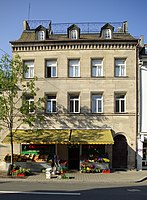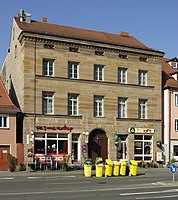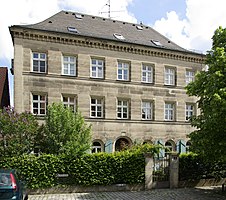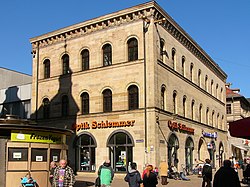Georg Cappeller
Georg Cappeller (born October 25, 1793 in Burgfarrnbach ; † March 16, 1855 in Stuttgart ) was a German architect in Nuremberg and Fürth .
Life
Early years
Johann Georg Cappeller was born on October 25, 1793 in Burgfarrnbach near Fürth as the son of Johann Kapeller and the Burgfarrnbacher farmer's daughter Anna Maria Dratz. Cappeller's father Johann Kapeller and his grandfather Joseph Kapeller were master masons and masons in Burgfarmbach.
Cappeller completed his apprenticeship as a stone cutter with his father, for whom he also worked as a journeyman for two years. From 1810 he worked in Nuremberg for the Royal Bavarian Agricultural Inspectorate under the building inspector Franz Xaver Keim , who also taught him drawing and planning for six years. In 1818 he became a member of the Albrecht Dürer Society, Nuremberg. In 1819 he made a trip to several German cities and to Prague and then studied for a quarter of a year at the architecture school of the Academy of Fine Arts Vienna . In 1821 he was granted the master's right as a stonemason and citizenship of the city of Nuremberg. He set up his workshop at Färberstrasse 56 in Nuremberg.
Nuremberg
In Nuremberg he restored the beautiful fountain and worked intensively with the architect Carl Heideloff from 1821 to 1824 . He built the Dürer-Pirckheimer-Brunnen according to his plans , supported him in the renovation of the Nuremberg churches and in the facade design of private houses. Through the intercourse with Heideloff he became acquainted with his sister Clementine Heideloff (1800–1866), whom he married in 1826. The marriage resulted in 9 children, including the sculptors Johannes Cappeller (1827-1883) and Viktor Cappeller (1831-1904) and the daughters Marie and Julie, who served Marie Countess Neipperg as chambermaids. From 1834 onwards, Cappeller severely restricted his construction business and was more concerned with the management and planning of buildings.
Fuerth
From 1840 to 1844, Cappeller took over the technical management of the new construction of the Fürth town hall , with the exception of the tower, which was built later. Between 1842 and 1844 he was also responsible for the construction of the buildings Kirchenplatz 3 and 7, Königstraße 74 and 92, Schwabacher Straße 22 and 32 and Waagstraße 3.
Retirement
After the completion of the town hall, Cappeller's temporary contract was not converted into a permanent position, contrary to his expectations. Various attempts to build up a new existence failed. Thereupon he founded a Fournier cutting factory in Nuremberg in 1846. However, the factory soon ran into financial difficulties and brought Cappeller to the brink of ruin. At the end of 1849 he moved with his wife to Stuttgart, where his sons Viktor and Johannes supported their parents financially.
Georg Cappeller died on March 16, 1855 at the age of 61 in Stuttgart. His wife survived him by 11 years and died on May 19, 1866 at the age of 66 in Stuttgart. Both were buried in a common grave on the Hoppenlauf cemetery in section 5b.
A career that had begun full of hope, during which Georg Capeller had been an able employee of his brother-in-law Karl Heideloff for almost two decades, ended in poor circumstances due to economic misjudgments.
Buildings
In addition to the restoration of the beautiful fountain and the construction of the Dürer-Pirckheimer fountain, Cappeller was involved in the renovation of the Nuremberg churches and the facade design of private houses in the 1820s. As a building officer in Fürth, he was responsible for the technical management of the new town hall and also responsible for the construction of town houses.
Memberships
- 1818: Albrecht Dürer Society, Nuremberg.
literature
- Manfred H. Grieb (editor): Nürnberger Künstlerlexikon . Visual artists, artisans, scholars, collectors, cultural workers and patrons from the 12th to the middle of the 20th century. Munich: KG Saur, 2007, page 215, pdf .
- Karl Klöpping: Historic cemeteries of old Stuttgart , Volume 1: Sankt Jakobus to Hoppenlau. A contribution to the history of the city with a guide to the graves of the Hoppenlauf cemetery . Stuttgart: Klett-Cotta, 1991, page 305, photo: 306.
- Brother-in-law Georg Kapeller, husband of Clementine Heideloff. In: Kurt Müller: Karl Alexander Heideloff's relatives in Nuremberg. In: Communications of the Association for the History of the City of Nuremberg Volume 77, 1990, pages 155–192, here: 176–183, pdf .
- Pfeiffer, Bertold: The Hoppenlau cemetery in Stuttgart. A homeland security study . Stuttgart: Kohlhammer, 1912, page 22, 57.
Web links
- Georg Capeller in the FürthWiki .
Footnotes
- ↑ Georg Cappeller, as the building officer of the city of Fürth, was responsible for the technical management of the construction of the Fürth town hall .
- ↑ Other spellings of the family name: Kapeller and Capeller ( # Müller 1990 , page 176).
- ↑ #Grieb 2007 .
- ↑ # Müller 1990 , pp. 176-178.
- ↑ #Pfeiffer 1912 , page 57.
- ^ Stuttgart address books 1855–1900.
- ↑ # Müller 1990 , page 178.
- ↑ # Müller 1990 , pp. 179-181.
- ↑ # Müller 1990 , pp. 181-183.
- ↑ #Pfeiffer 1912.1 ; # Klöpping 1991 .
- ↑ # Müller 1990 , page 183.
- ↑ #Grieb 2007 .
| personal data | |
|---|---|
| SURNAME | Cappeller, Georg |
| ALTERNATIVE NAMES | Capeller, Johann Georg (full name) |
| BRIEF DESCRIPTION | German architect |
| DATE OF BIRTH | October 25, 1793 |
| PLACE OF BIRTH | Burgfarrnbach |
| DATE OF DEATH | March 16, 1855 |
| Place of death | Stuttgart |







